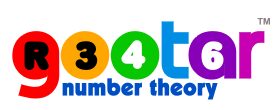Major Chords are Primary Colors...
©2004
gootar - chords theory, By James C. Cranwell, 04/20/2004
| red |
orange |
yellow |
green |
blue |
indigo |
violet |
Seven Colors in a Rainbow
It is well known there are seven colors in a rainbow... Isaac Newton, a pioneer in the field of colour, passed a beam of sunlight through a prism. When the light came out of the prism it was not white but was spread into rays composed of
seven different colours: Red, Orange, Yellow, Green, Blue, Indigo and Violet.
The spreading into rays was called dispersion by Newton and he called the different coloured rays the spectrum. He learnt that when the light rays were passed again through a prism the rays turned back into white light. If only one ray was passed through the prism it would come out the same colour as it went in. Newton concluded that white light was made up of seven different coloured rays. They are just one part of the electromagnetic spectrum... the part (frequencies) that are visible/discernable to the human eye. There are also a plethora of frequencies and colors in between these seven colors and ones we can't see, for instance radio ways, ultra-violet and infra-red.
Notice the first, third and fifth colors are red, yellow and blue.
| C |
D |
E |
F |
G |
A |
B |
| Root |
Second |
Third |
Fourth |
Fifth |
Sixth |
Seventh |
| E |
F# |
G# |
A |
B |
C# |
D# |
Seven Notes in a Scale
Anyone delving into music theory knows there are seven notes in a musical scale. Using a C major scale and an E major scale as examples we have the patterns noted above. The center section... Root, second, third, fourth, fifth, sixth and seventh are the scale degrees relative to the root note (the root note can be any note). Chords are a combination of three or more notes in a scale. Major chords are comprised of the Root, third and fifth notes of any major scale. Major chords are the basis of all other chord structures.

There are also an abundance of other frequencies (tones/vibrations) in the sound spectrum, but the
notes in the scale will repeat themselves the further higher and lower you go up and down in frequency. Notes of the same tone but different pitch are called octaves, for instance, "A-440" is an abbreviation for the official government standard of musical pitch in the United States. Related to pianos, it means that the strings for the "A" just above "middle C" should vibrate at 440 cycles per second. Higher and lower A's will vibrate at 880 and 220 respectively. (notice the frequencies are equal divisors of each other... either double or half)
The
light waves (electromagnectic spectrum) are also doing this, we just can't see the higher and lower frequencies because unlike intermittent sounds, we are constantly being bombarded with
light, radio and other waves. If we could actually see all of them, it would probably appear as just a big soupy mess... an analogy using sound would be like hitting all of the piano keys at the same time. I guess our brains just picked out a nice section of the electromagnetic field (the scale of light) and made it visible. So, there are seven color frequencies and seven sound frequencies used by our eyes and ears for sight, hearing, art, music, painting, song writing, etc.
The Color Wheel
A color circle, based on red, yellow and blue, is traditional in the field of art. Sir Isaac Newton developed the first circular diagram of colors in 1666. Since then scientists and artists have studied and designed numerous variations of this concept. Differences of opinion about the validity of one format over another continue to provoke debate. In reality, any color circle or color wheel which presents a logically arranged sequence of pure hues has merit.
|
 Primary Colors Primary Colors
Red, yellow and blue |
|
 Secondary Colors Secondary Colors
Green, orange and purple |
|
 Tertiary Colors Tertiary Colors
Yellow-orange, red-orange, red-purple, blue-purple, blue-green and yellow-green. |
| In traditional color theory, these are the 3 pigment colors that can not be mixed or formed by any combination of other colors. All other colors are derived from these 3 hues |
|
These are the colors formed by mixing the primary colors. |
|
These are the colors formed by mixing one primary and one secondary color |
The mysterious correlation of light and sound.
The first, third and fifth colors of the rainbow are Primary colors... red, yellow and blue.
The first, third and fifth notes of a major scale is a Major chord... root, third and fifth.
Something quite amazing happens when we tie all of this information together (that's Physics, Optics, Light, Sight, Sound, Hearing, Art, Music, Neuroscience) and line up the two groups of seven up together...
Primary Colors are Major Chords!
Red
Root |
Orange
Second |
Yellow
Third |
Green
Fourth |
Blue
Fifth |
Indigo
Sixth |
Violet
Seventh |
If you could actually "hear" the extremely high frequencies the red, yellow and blue (primary color) light waves are vibrating at... you would hear a Major chord.
If you could "see" the sound of notes in a major chord relative to the same "rainbow scale" used by light... you would see notes and chords in primary color just like way they are used in the chord diagram program above.
Special thanks to
Google
for inadvertently making me think of this, and J.L. Morton



Note: If you're a guy and all the red colors look similar to you? Here's why...
You can be seeing that tomato but I can't be seeing it.
If you like this program and want your own copy...
Program Sales -
Other Programs -
Contact -
Help!
©2004 gootar - Generating 3,919,104 Gootar chords, By James C. Cranwell, 04/20/2004


 There are also an abundance of other frequencies (tones/vibrations) in the sound spectrum, but the notes in the scale will repeat themselves the further higher and lower you go up and down in frequency. Notes of the same tone but different pitch are called octaves, for instance, "A-440" is an abbreviation for the official government standard of musical pitch in the United States. Related to pianos, it means that the strings for the "A" just above "middle C" should vibrate at 440 cycles per second. Higher and lower A's will vibrate at 880 and 220 respectively. (notice the frequencies are equal divisors of each other... either double or half)
There are also an abundance of other frequencies (tones/vibrations) in the sound spectrum, but the notes in the scale will repeat themselves the further higher and lower you go up and down in frequency. Notes of the same tone but different pitch are called octaves, for instance, "A-440" is an abbreviation for the official government standard of musical pitch in the United States. Related to pianos, it means that the strings for the "A" just above "middle C" should vibrate at 440 cycles per second. Higher and lower A's will vibrate at 880 and 220 respectively. (notice the frequencies are equal divisors of each other... either double or half)
 Primary Colors
Primary Colors  Secondary Colors
Secondary Colors  Tertiary Colors
Tertiary Colors